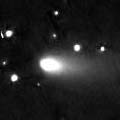
|
It is already very bright and visible visually, 8.8 mag on Apr. 11 (Juan Jose Gonzalez). Very strongly condensed. The stellar false nucleus and the broad tail are clearly visible visually. It has been brightening rapidly well, but the brightening evolution is slightly slower than originally expected. It will pass only 0.08 A.U. from the earth on May 12, remarkable approach after 76 years since its discovery in 1930. It will be 4 mag at best, and will be visible with naked eyes. But the reported brightness in April was a bit fainter than this ephemeris. So the brightness evolution may be getting slower. Now totally four components, C, B, G and R, are visible bright. It keeps observable in good condition all through the encounter in May, while it will be brightening rapidly. Due to the approach of the comet, Bootids meteor shower observed in 1930 may appear in outburst again in May and June. But the earth will not pass through the dust trail in calculation.
Date(TT) R.A. (2000) Decl. Delta r Elong. m1 Best Time(A, h)
Apr. 8 14 53.59 21 48.6 0.320 1.265 140 8.9 1:49 ( 0, 77)
Apr. 15 15 10.91 24 22.5 0.255 1.205 138 8.1 1:39 ( 0, 79)
|
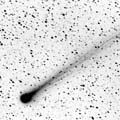
|
It reached to 5.2 mag at best in late February and early March. The fading had been slow in March, however, it turned to be fading rapidly in April. Now it is 9.0 mag (Apr. 11, Juan Jose Gonzalez). In the Northern Hemisphere, it keeps observable in good condition until it fades out. It will be fading gradually in the morning sky after this. It will be fainter than 13 mag in late May.
Date(TT) R.A. (2000) Decl. Delta r Elong. m1 Best Time(A, h)
Apr. 8 23 3.92 54 3.3 1.358 1.102 53 8.7 4:11 (222, 29)
Apr. 15 23 34.81 57 31.8 1.519 1.216 52 9.6 4:00 (218, 29)
|
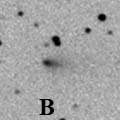
|
It had been brightening well as expected until late March. It was 11.9 mag on Mar. 31 (Seiichi Yoshida). However, an unexpected outburst happened on Apr. 2, and it reached to 9.2 mag (Apr. 7, Maciej Reszelski). Now it is almost as bright as the component C. It was moderately condensed until late March, but the central condensation became extremely strong and the stellar false nucleus was clearly visible in early April. However, the condensation turned to be unusually elongated in mid April, which will be a sign of disruption. It is also getting diffused visually. If it keeps the current brightness, it will reach to 4 mag at the remarkable approach in May, as bright as the component C, and become a naked eye object, too. However, it can disappear before that.
Date(TT) R.A. (2000) Decl. Delta r Elong. m1 Best Time(A, h)
Apr. 8 14 40.80 22 56.7 0.326 1.274 142 9.3 1:37 ( 0, 78)
Apr. 15 14 53.95 25 42.7 0.261 1.213 139 10.1 1:22 ( 0, 81)
|
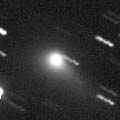
|
It has been visible visually in the southern low sky since last August. It has been bright as 10 mag for three months since December. It will be too low to observe soon. It will appear in the morning sky again in late August at 13.5 mag. It will come to locate high in October, then it will be visible visually again at 14 mag.
Date(TT) R.A. (2000) Decl. Delta r Elong. m1 Best Time(A, h)
Apr. 8 2 25.97 25 34.9 2.468 1.635 26 10.5 19:53 (116, 8)
Apr. 15 2 48.99 27 33.6 2.521 1.673 25 10.6 20:00 (119, 7)
|

|
It had been originally expected to reach to 9 mag at best. But the brightness evolution has been very slow, and it is much fainter than expected actually. It was expected to be observable at 10 mag in the Southern Hemisphere in last autumn, however, it was only 12-13 mag actually. Then, it had been too low even in the Southern Hemisphere from January to February, and only few observations were reported. However, it is getting observable finally in the morning sky also in the Northern Hemisphere. It will be observable in good condition after this until autumn. It was 12.6 mag on Mar. 30 (Katsumi Yoshimoto). It will be visible bright as 12 mag for a while.
Date(TT) R.A. (2000) Decl. Delta r Elong. m1 Best Time(A, h)
Apr. 8 20 17.54 -14 23.3 1.770 1.789 74 11.9 4:11 (310, 24)
Apr. 15 20 9.50 -10 29.1 1.666 1.832 82 11.8 4:00 (313, 31)
|
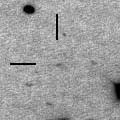
|
Although it was faint as 15.9 mag still on Apr. 2, it brightened rapidly since Apr. 5. Now it became bright as 12.2 mag and visible visually (Apr. 7, Andreas Kammerer). In late March, this component was splitted into two piecies and looked double nuclei. But the new fragment disappeared in early April. If it keeps the current brightness, it will reach to 8 mag at the remarkable approach in May. However, if the rapid brightening in early April was a temporary outburst due to the nucleus split, it may fade out after this.
Date(TT) R.A. (2000) Decl. Delta r Elong. m1 Best Time(A, h)
Apr. 8 14 38.54 23 8.3 0.327 1.276 142 13.0 1:35 ( 0, 78)
Apr. 15 14 50.98 25 56.0 0.263 1.215 139 11.9 1:19 ( 0, 81)
|
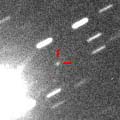
|
It has been brightening up to 15.2 mag on Mar. 14 (Ken-ichi Kadota). It is getting brighter rapidly in the morning sky. It was fainter than 13.0 mag and not visible visually on Mar. 31 (Seiichi Yoshida). But it will become visible visually soon. It will reach to 12 mag in June. The condition is best beucase it is almost at opposition at the perihelion passage. However, it will be very low, only 13-20 deg high, from June to September in the Northern Hemisphere. When it gets higher again, it will be fainter than 14 mag, too faint to see visually.
Date(TT) R.A. (2000) Decl. Delta r Elong. m1 Best Time(A, h)
Apr. 8 17 48.64 -21 37.9 1.024 1.665 110 13.6 4:11 (351, 33)
Apr. 15 18 3.45 -22 38.6 0.956 1.643 114 13.3 4:00 (351, 32)
|
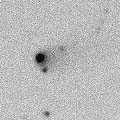
|
It brightened faster than a typical comet, and became visible visually as 13.5 mag in October (Oct. 24, Seiichi Yoshida). Now it is still bright as 13.4 mag (Feb. 27, Seiichi Yoshida). Small and strongly condensed. Because it is distant from the sun, it keeps observable at 13.5 mag in good condition for a long time until 2006 June.
Date(TT) R.A. (2000) Decl. Delta r Elong. m1 Best Time(A, h)
Apr. 8 9 38.42 50 34.2 4.808 5.191 107 13.6 20:32 (180, 75)
Apr. 15 9 39.17 49 47.6 4.889 5.191 102 13.7 20:05 (180, 75)
|

|
In 2005, outbursts occured in September and November, when it brightened up to 12.5-13 mag. It had been faint as around 15 mag in December and January. However, it has been bright at around 13 mag since late January. It was still bright as 13.2 mag on Mar. 18 (Rolando Ligustri). But it will be too low to observe soon.
Date(TT) R.A. (2000) Decl. Delta r Elong. m1 Best Time(A, h)
Apr. 8 2 34.58 23 41.6 6.674 5.800 26 13.8 19:53 (113, 9)
Apr. 15 2 40.37 24 3.6 6.721 5.801 21 13.9 20:00 (117, 4)
|

|
Although it was extremely faint as 20.5 mag still on Mar. 25, it brightened rapidly and reached to 15.1 mag on Apr. 7 (Rik Hill). It is already visible visually as 14.4 mag (Apr. 7, Maciej Reszelski). If it keeps the current brightness, it will reach to 10 mag at the remarkable approach in May. However, the future brightness evolution is uncertain because this is a tiny component.
Date(TT) R.A. (2000) Decl. Delta r Elong. m1 Best Time(A, h)
Apr. 8 14 37.36 23 14.2 0.328 1.277 142 14.8 1:33 ( 0, 78)
Apr. 15 14 49.39 26 2.5 0.263 1.216 139 14.0 1:18 ( 0, 81)
|

|
Although it was not observed in its last return in 1999, it will be observable in good condition after the periheliion passage in this return. It will reach to 14.5 mag from June to August. It is not observable still now, but it will appear at dawn in May.
Date(TT) R.A. (2000) Decl. Delta r Elong. m1 Best Time(A, h)
Apr. 8 23 19.17 -6 46.4 2.841 2.037 30 15.6 4:11 (275, -5)
Apr. 15 23 32.37 -4 24.2 2.791 2.024 32 15.4 4:00 (274, -3)
|
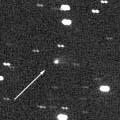
|
It will pass the perihelion soon, in 2006 February. But it did not brightened so much as expected, 15.7 mag on Dec. 18 (Ken-ichi Kadota). It keeps observable at 15-16 mag for a long time from 2005 spring to the end of 2006. Because it moves in the northern sky, it keeps observable for a long time in the Northern Hemisphere. It is brightest until May, but keeps lower than 30 deg high.
Date(TT) R.A. (2000) Decl. Delta r Elong. m1 Best Time(A, h)
Apr. 8 23 12.31 53 47.1 3.749 3.232 52 15.7 4:11 (222, 28)
Apr. 15 23 26.93 53 46.1 3.782 3.241 50 15.7 4:00 (222, 28)
|
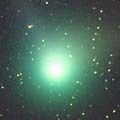
|
It was fantastic, so bright as 3.5 mag, so large as 30 arcmin, locating high overhead at its best time in early 2004 January. Then it has been getting fainter gradually, and become already too faint to see visually. However, it is still bright as 15.8 mag by CCD observations (Mar. 30, Katsumi Yoshimoto). It keeps observable until October when it becomes fainter than 18 mag.
Date(TT) R.A. (2000) Decl. Delta r Elong. m1 Best Time(A, h)
Apr. 8 16 57.12 2 22.0 4.803 5.395 121 15.7 3:53 ( 0, 57)
Apr. 15 16 54.56 2 38.4 4.784 5.460 128 15.8 3:23 ( 0, 58)
|
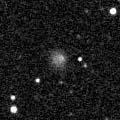
|
It had been an extremely faint Centaur asteroid until 2004, fainter than 21 mag. However, it brightened up to 17.5 mag on 2005 Dec. 30, and a coma was observed, then it was revealed to be a comet. It brightened furthermore, 14.8 mag on Jan. 7 (Ken-ichi Kadota). It was also visible visually at 14.4 mag (Jan. 8, Seiichi Yoshida). It still keeps bright as 15.7 mag on Apr. 2 (Giovanni Sostero and Ernesto Guido). Now the condensation of the outburst looks separatedly from the nucleus. Because it is a temporary brightening in outburst, it will return to be so faint as 21 mag in the near future. It will pass the perihelion in 2015. The heliocentric distance reduces down to 5.9 A.U., but it will be 17 mag at best. However, another outburst may happen again in the future.
Date(TT) R.A. (2000) Decl. Delta r Elong. m1 Best Time(A, h)
Apr. 8 13 8.29 -5 9.0 11.897 12.897 178 15.8 0:05 ( 0, 50)
Apr. 15 13 6.64 -4 58.4 11.890 12.885 172 15.9 23:32 ( 0, 50)
|
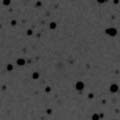
|
Great outburst over 6 mag has occured always in recent appearances in 1995 and 2001. The ephemeris says it will be 14 mag at best, but the actual brightness evolution will not be along the prediction. It is expected to be visible visually due to an unpredicted outburst again in this return. It is 15.4 mag on Apr. 12 (Toni Scarmato), already brighter than this ephemeris. Although it will not approach to the earth so much in this return, it keeps observable all through the period in the evening sky until autumn. It becomes brightest in June and too faint in autumn. It keeps locating around 30 degree high after May.
Date(TT) R.A. (2000) Decl. Delta r Elong. m1 Best Time(A, h)
Apr. 8 6 14.56 23 2.9 1.193 1.351 75 16.2 19:53 ( 83, 53)
Apr. 15 6 30.35 23 49.8 1.186 1.298 72 15.9 20:00 ( 87, 49)
|
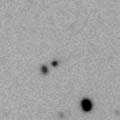
|
It was so faint as 18.5 mag at the discovery in early December, but it brightened up to 17 mag in mid January. Then it started brightening extremely rapidly after mid January. It was visible visually as bright as 14.0 mag in late February (Feb. 27, Seiichi Yoshida). Very strongly condensed and almost stellar. It will be observable in good condition, however, it will fade out soon after April.
Date(TT) R.A. (2000) Decl. Delta r Elong. m1 Best Time(A, h)
Apr. 8 10 38.12 26 21.6 0.988 1.809 130 15.9 21:32 ( 0, 81)
Apr. 15 10 45.66 26 29.9 1.046 1.825 125 16.4 21:12 ( 0, 81)
|
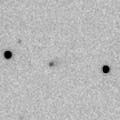
|
It brightened faster than a typical comet, and it reached to 15.8 mag on Feb. 9 (Ken-ichi Kadota). It will be observable in good condition as 16 mag for a long time until next spring. It was too faint to see visually, fainter than 13.9 mag (Mar. 31, Seiichi Yoshida).
Date(TT) R.A. (2000) Decl. Delta r Elong. m1 Best Time(A, h)
Apr. 8 10 16.42 64 30.2 4.691 4.993 101 16.1 21:10 (180, 61)
Apr. 15 10 16.31 63 37.0 4.760 4.998 97 16.2 20:42 (180, 61)
|

|
In addition to the bright three components, C, B, G and R, about 40 faint components have been discovered. They seem to have been separated from the component B. Now the component R is brightest at 17.8 mag. The other components are extremely faint. They are tiny fragments and the brightness change is very uncertain. Some of them are being splitted or already fading. But they may brighten rapidly as the component R did, so observations are encouraged. Some of them will be visible visually at the remarkable approach in May.
Date(TT) R.A. (2000) Decl. Delta r Elong. m1 Best Time(A, h)
Apr. 8 14 36.18 23 21.3 0.329 1.278 142 17.0 1:32 ( 0, 78)
Apr. 15 14 47.85 26 10.3 0.265 1.217 139 16.1 1:16 ( 0, 81)
|
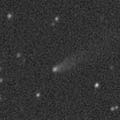
|
Although it was faint as 18 mag at the discovery in 2004 November, then it brightened very rapidly until early 2005, and reached to 16.0 mag on May 7 (Ken-ichi Kadota). After it appeared in the morning sky again, it continued brightening furthermore, and reached to 14.7 mag on Nov. 22 (Ken-ichi Kadota). But it already faded down to 16.2 mag by CCD observations (Mar. 14, Ken-ichi Kadota). However, it is still bright visually as 14.4 mag (Mar. 29, Maciej Reszelski). In the Northern Hemisphere, it keeps observable in good condition until summer when it becomes too faint.
Date(TT) R.A. (2000) Decl. Delta r Elong. m1 Best Time(A, h)
Apr. 8 13 46.95 15 15.0 1.962 2.903 155 16.2 0:44 ( 0, 70)
Apr. 15 13 41.18 15 9.3 1.991 2.932 155 16.4 0:11 ( 0, 70)
|
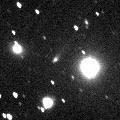
|
It had been observed at 16 mag by CCD, or 14 mag visually, in spring and summer in 2005. Now it is appearing again in the morning sky. It will be observable again at 16 mag in spring and summer in 2006. But the altitude will be somewhat lower than in 2005.
Date(TT) R.A. (2000) Decl. Delta r Elong. m1 Best Time(A, h)
Apr. 8 19 44.68 -2 39.1 3.925 3.892 80 16.4 4:11 (309, 39)
Apr. 15 19 46.45 -3 15.8 3.835 3.912 86 16.3 4:00 (313, 40)
|
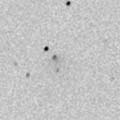
|
It passes the perihelion in 2006 February. But it is outside of Jupiter's orbit. So it keeps 17 mag for a long time. Because it moves in the northern sky, it keeps locating high and observable in good condition until 2006 summer.
Date(TT) R.A. (2000) Decl. Delta r Elong. m1 Best Time(A, h)
Apr. 8 14 39.95 69 50.8 6.538 6.808 101 16.7 1:37 (180, 55)
Apr. 15 14 28.54 69 40.8 6.563 6.811 100 16.7 0:58 (180, 55)
|
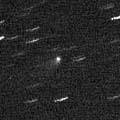
|
It was visible visually as 14.3 mag in 2005 spring (July 10, Edwin van Dijk). Now it is 16.6 mag (Feb. 5, Ken-ichi Kadota). Although it had kept 16.5 mag since December until early April, it will fade out rapidly after this, and become fainter than 18 mag in July.
Date(TT) R.A. (2000) Decl. Delta r Elong. m1 Best Time(A, h)
Apr. 8 11 36.30 19 50.8 3.375 4.236 145 16.7 22:28 ( 0, 75)
Apr. 15 11 24.47 20 8.5 3.487 4.273 136 16.8 21:49 ( 0, 75)
|
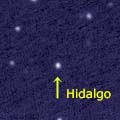
|
It reached to 13 mag and was observed visually in good condition in 2004 autumn. It has been not observable since August, but it is appearing at dawn again. It keeps 17 mag until late April. But it will go away soon after that. Next return is in 2018, when it will be 14.3 mag at best.
Date(TT) R.A. (2000) Decl. Delta r Elong. m1 Best Time(A, h)
Apr. 8 12 54.93 6 26.7 3.235 4.215 166 16.8 23:47 ( 0, 61)
Apr. 15 12 48.79 6 20.3 3.296 4.256 160 16.9 23:14 ( 0, 61)
|

|
Although it is not observable around the perihelion passage, it is observable at 17-17.5 mag in good condition both in spring and autumn.
Date(TT) R.A. (2000) Decl. Delta r Elong. m1 Best Time(A, h)
Apr. 8 8 5.74 63 4.4 1.804 2.069 90 17.4 19:53 (167, 61)
Apr. 15 7 33.26 59 52.6 1.905 2.024 81 17.5 20:00 (151, 58)
|
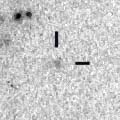
|
It is observable at 17.7 mag in 2006 spring. It is also observable at 17.5 mag in 2007 spring, but the altitude will be a bit lower.
Date(TT) R.A. (2000) Decl. Delta r Elong. m1 Best Time(A, h)
Apr. 8 11 10.65 8 44.3 3.963 4.835 147 17.8 22:04 ( 0, 64)
Apr. 15 11 8.40 8 51.8 4.020 4.830 139 17.8 21:34 ( 0, 64)
|
|
![]()
 102P/Shoemaker 1
102P/Shoemaker 1 C/2005 B1 ( Christensen )
C/2005 B1 ( Christensen ) C/2004 Q2 ( Machholz )
C/2004 Q2 ( Machholz ) 174P/(60558) 2000 EC98 ( Echeclus )
174P/(60558) 2000 EC98 ( Echeclus ) 41P/Tuttle-Giacobini-Kresak
41P/Tuttle-Giacobini-Kresak P/2005 XA54 ( LONEOS-Hill )
P/2005 XA54 ( LONEOS-Hill ) C/2004 D1 ( NEAT )
C/2004 D1 ( NEAT ) 73P/Schwassmann-Wachmann 3 (fainter fragments)
73P/Schwassmann-Wachmann 3 (fainter fragments) P/2004 VR8 ( LONEOS )
P/2004 VR8 ( LONEOS ) C/2005 K1 ( Skiff )
C/2005 K1 ( Skiff ) C/2002 VQ94 ( LINEAR )
C/2002 VQ94 ( LINEAR ) C/2004 K1 ( Catalina )
C/2004 K1 ( Catalina ) (944) Hidalgo
(944) Hidalgo C/2006 CK10 ( Catalina )
C/2006 CK10 ( Catalina ) 99P/Kowal 1
99P/Kowal 1![]()




















